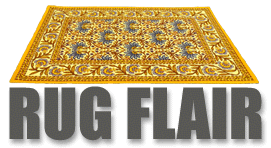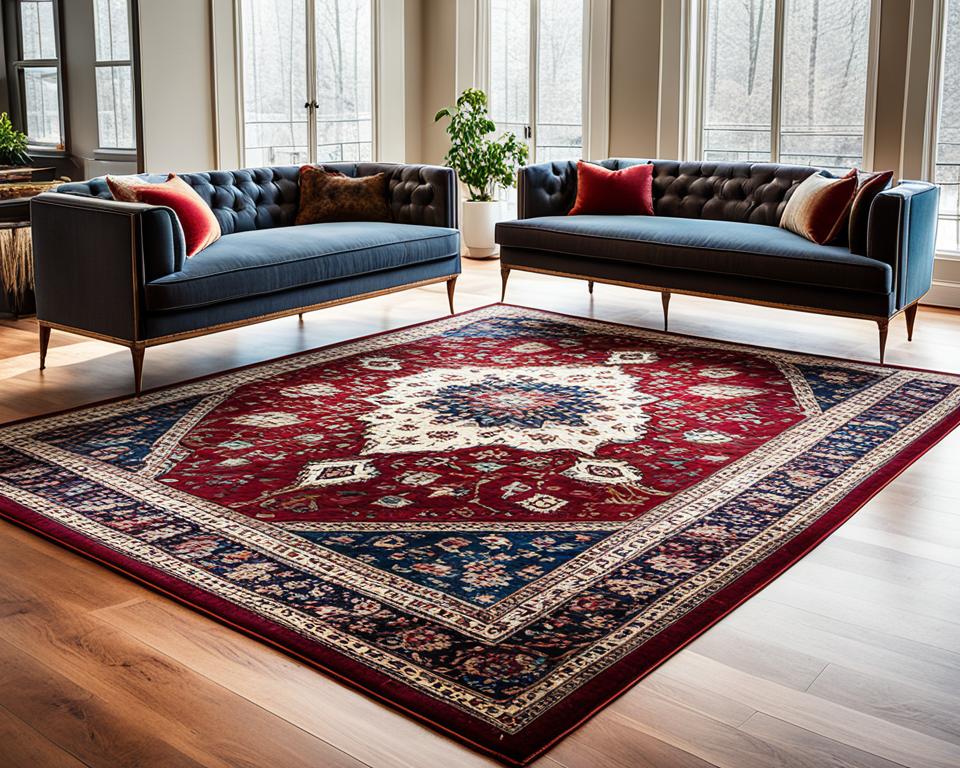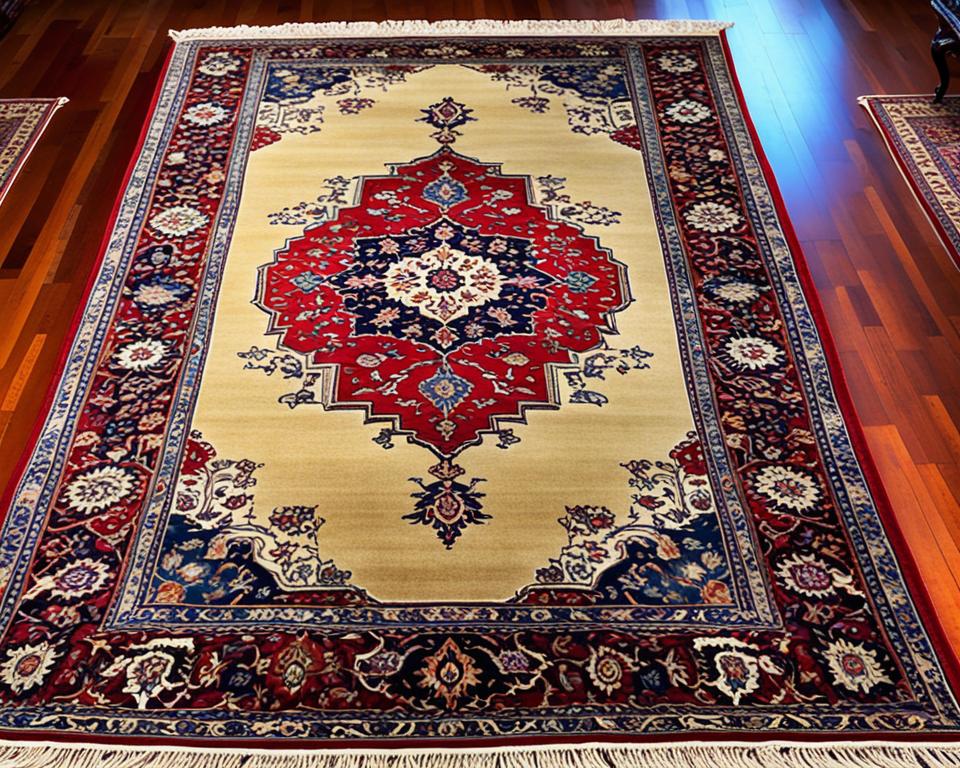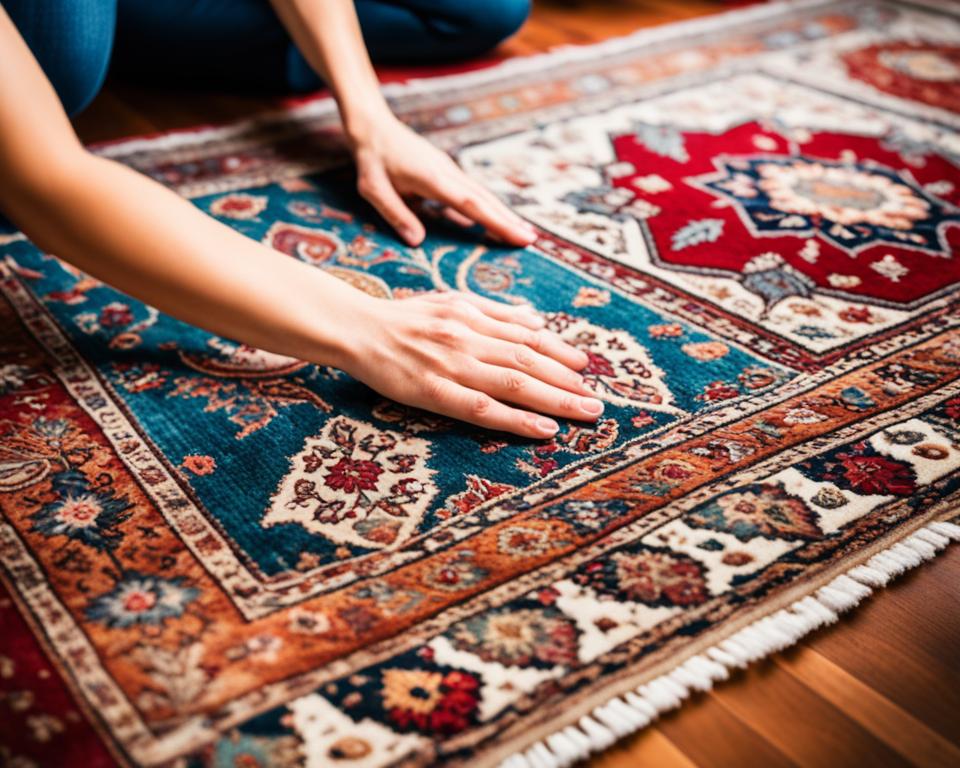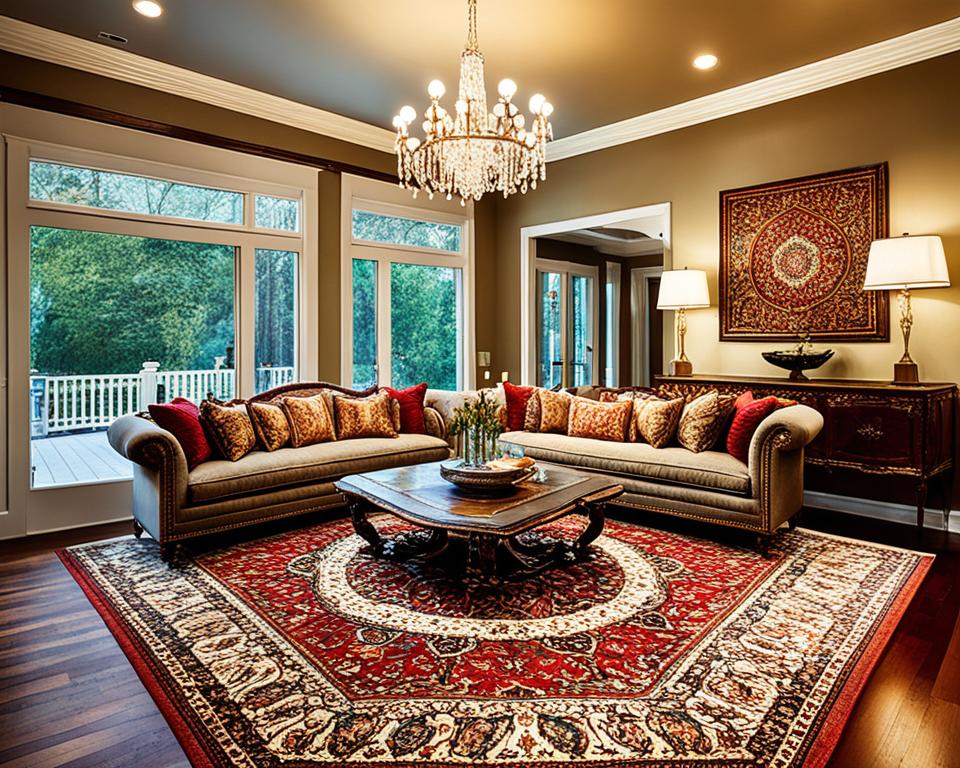Are you in search of an exquisite addition to your home décor? Imagine the unparalleled elegance and timeless beauty that the Best Persian Rugs can bring into your space. These aren’t just luxury rugs; they are stories woven into the fabric of history, available now to grace your floors with their unparalleled charm. Each piece, a handcrafted marvel of traditional Persian carpets, emanates the high-quality craftsmanship passed down through centuries of culture directly from Iran. With the promise of a curated selection, complete with free shipping across the UK, acquire a piece of history that continues to captivate with its intricate design and superior durability.
As you envision the transformation of your personal oasis, remember that your selections are backed by a commitment to satisfaction since 1998, with a 31-day money-back guarantee, free returns, and expert advice only a click away. Whether you’re an aficionado of handmade Oriental rugs or a seeker of high-quality area rugs, the journey to find the best begins here.
Key Takeaways
- Time-honored tradition and luxury converge in our selection of the Best Persian Rugs.
- Enhance your home with the opulence and warmth of handcrafted traditional Persian carpets.
- Trust in a legacy of expertise since 1998, offering handpicked high-quality area rugs with a customer-first approach.
- Enjoy peace of mind with our stellar purchase policies, including free shipping and a 31-day money-back guarantee.
- Connect with the heritage of Iran through each authentic, handmade Oriental rug, ensuring sustainable luxury in your living space.
The Rich Heritage of Persian Rugs
As you delve into the world of authentic Persian carpets, you embark on a voyage through time and tradition. These weavings are not mere floor coverings; they are the embodiment of an ancient legacy—one of opulence and detailed storytelling, where the beauty of the past is knotted into every fiber. These historic treasures continue to captivate Persian rug collectors and connoisseurs of premium Persian carpets alike.
Origins and Historical Significance
The journey of the traditional Persian carpet began over two and a half millennia ago in the expansive lands of ancient Persia, the heart of today’s Iran. Embraced by the royalty and nobility, these luxurious textiles became a symbol of prestige during the reign of Cyrus the Great. Marking the golden age under the rule of the Safavid Dynasty, Persian rug making evolved into an art form so refined, it garnished the courts and grandiose settings of the time.
Art of Persian Rug Weaving
In the world of traditional Persian carpets, the artisan’s loom weaves more than just threads—it weaves history and tradition. The intricate weaves, elaborate patterns, and the labor of love poured into each rug narrates a different tale, passed down from one generation of weaver to the next. This heritage of handcrafting is what distinguishes these carpets as genuine heirlooms of the Persian empire.
Preserved Antique Collections and Their Value
Echoes of an opulent past resonate through preserved antique Persian rugs, each weave a verse in the poetic history of its origin. Today, collectors treasure the singular nature of each piece, as every knot and dye holds the quintessence of bygone prosperity. To lay eyes upon these venerable creations is to witness the undying splendor of Persian culture.
Understanding the Craftsmanship of Handmade Oriental Rugs
Picture this: an intricate tapestry of vibrant hues and elaborate designs beneath your feet, transforming your space into a testament of ancient artistry. These aren’t mere decorations; they are handmade Oriental rugs, each a canvas where years of tradition and craftsmanship intertwine. To fully appreciate the splendor of these high-quality area rugs, one must delve into the painstaking process that brings them to life.
Imagine the skilled hands of a weaver, diligently tying knot after knot, their fingers moving with precision honed by decades of familial legacy. It’s a labor of love and patience that takes months, or years, to fashion a single rug. The finest hand-spun woolen yarn—harvested from the pastoral hillsides of Iran—is dyed with pigments extracted from nature: vibrant madder root reds, deep indigo blues, and earthy ochre yellows. Their colors sing of the land they come from, echoing the tales and traditions of a bygone era.
Yet, it’s not just the materials and methods that make these rugs extraordinary. It’s the very soul poured into them by the artisan creators—a soul that you can feel underfoot in the texture and warmth these rugs bring to your home. Perfect for a cozy living room gathering or a child’s room ripe with imagination, these rugs bear witness to the art of storytelling through woven threads. Each pattern, a chapter from an ancient book; every color, a word in the language of elegance.
Let’s delve deeper into the core of what makes each rug a unique work of art:
- Hand-knotting technique: The density of knots per square inch, with some reaching over a million knots, defines not only the rug’s intricate designs but also its value and longevity.
- Natural dyes and materials: Unlike synthetic alternatives, the natural dyes used in these rugs ensure that not only are they kinder to the environment, but they also develop a patina over time that enhances their beauty.
- Each rug’s story: Behind every design lies a narrative, from the weaver’s interpretation of Persian folklore to the rich scenery that inspired the particular motif.
This, your invitation to bring home more than just a rug, but a piece of history, where every weave is a connection to a craftsman’s pride and a culture’s rich tapestry. Indulge in the unparalleled craftsmanship of handmade Oriental rugs—the epitome of high-quality area rugs—and let them tell their time-honored stories in your own home.
Types of Persian Rugs and Their Unique Features
Each Persian rug is a tapestry of history and heritage, weaving together traditions that speak volumes about the culture and artistry of Iran. In exploring the various types of handmade Persian rugs, one finds distinct styles that have evolved through generations, endowed with motifs and techniques as diverse as the regions from which they originate. From the visually stunning floral designs of Kirman to the robust narratives depicted in Bakhtiari rugs, these pieces are not merely decorative items but storied canvases that resonate with cultural significance and artistic mastery.
Bakhtiari Rugs: Colorful Narratives in Wool
Bakhtiari rugs are a celebration of color and story, woven by skilled artisans who capture life’s vibrancy through woolen weaves. Best known for depicting verdant gardens and lively animals, these rugs are more than floor coverings—they’re a manifesto of pastoral life and nature’s bounty.
Tabriz Rugs: Elegance in Silk and Wool
The city of Tabriz gives rise to rugs renowned for their sophisticated designs and the subtle interplay of silk and wool. Each piece tells its own tale, be it of nature’s serenity or the grand narratives of history, woven into the fine threads of these treasured pieces.
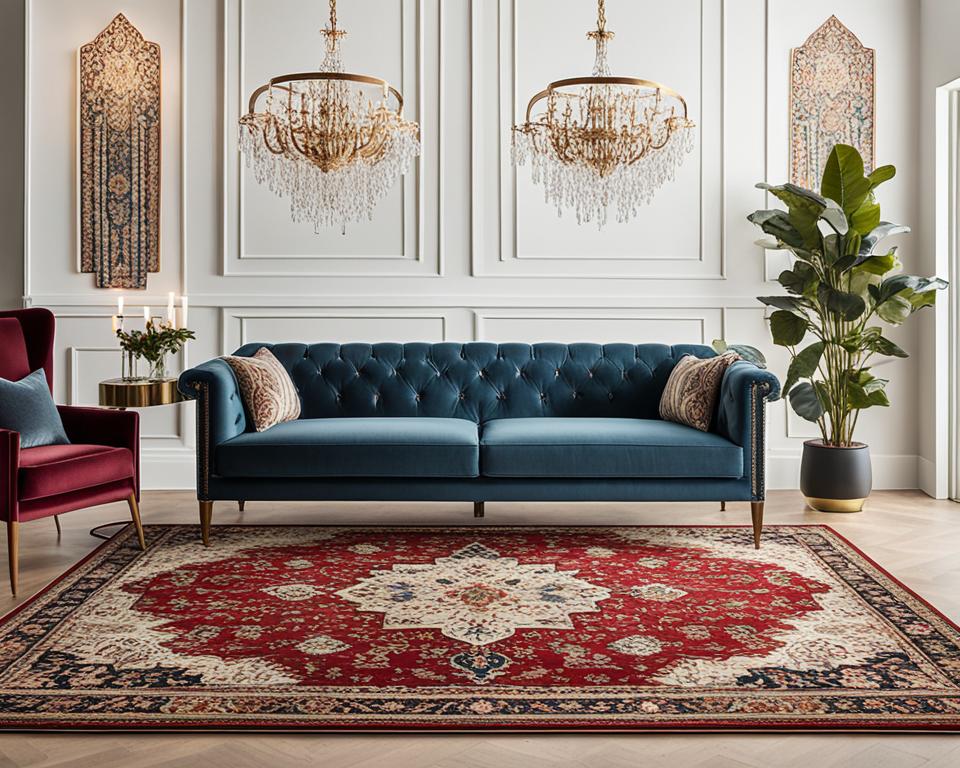
Kirman Rugs: Intricate Design and Premium Quality
Each handcrafted Kirman rug is a testament to the precision and dedication of its weavers. Known for complex floral patterns and vibrant color combinations, these rugs are sought after by collectors and designers alike, setting the gold standard for quality and beauty in Persian carpets.
Gabbeh Rugs: A Modern Twist on Tradition
Gabbeh rugs represent the fusion of traditional craftsmanship with modern aesthetics. With their high pile and abstract designs, these rugs usher in an air of creativity and singularity, marking them as a distinct and imaginative take on the ancient Persian rug-making tradition.
| Rug Type | Region | Material | Design Motifs | Characteristics |
|---|---|---|---|---|
| Bakhtiari | Chaharmahal and Bakhtiari | Wool | Gardens, Animals | Colorful, Traditional |
| Tabriz | Azerbaijan | Silk and Wool | Nature Scenes, Historical Narratives | Sophisticated, Fine Weave |
| Kirman | Kerman Province | Wool, occasionally Silk | Floral Patterns, Luxurious Colors | Intricate, High-value |
| Gabbeh | Fars Province | Wool | Abstract, Modern Designs | Creative, Thick Pile |
Whether you’re drawn to the elegant Kirman Rugs for sale, the robust narratives of Bakhtiari pieces, the dignified grace of Tabriz Rugs, or the abstract creativity of Gabbeh Rugs, each rug brings with it a piece of Persian history and a chance to partake in the ancient ritual of storytelling through art. Let the rich heritage of Persian rugs transform your space into a gallery of tradition and craftsmanship.
Persian Rug Materials: Silk, Wool, and Cotton
When you think of Persian rug materials, think of a luxurious symphony composed of silk, wool, and cotton. Each material plays a unique role in crafting the masterpiece that is a Persian rug. To truly understand the value and splendor each fiber brings, let’s explore why silk rugs demand higher prices, wool rugs are universally cherished, and cotton rugs serve as a foundational element in these exquisite pieces of art.
Silk rugs stand out with their sheer brilliance and intricate detailing. Revered for their exceptional durability and fine texture, silk fibers allow for finer knots, facilitating complex designs which beam with an elegant luster. This opulence comes with a higher price tag, making them treasures often reserved for the most luxurious settings.
In the world of wool rugs, comfort and longevity are key. Wool, with its soft and plush qualities, is the most prevalent material found in Persian rugs. Its abundance in the highlands of Iran ensures a continued tradition of woolen rug crafting. Moreover, wool’s natural durability translates to a lifespan that generations can cherish, perfect for high-traffic areas in your home.
Lastly, cotton rugs form the backbone of many Persian designs due to cotton’s strength and flexibility, providing a sturdy structure for wool or silk pile. Persian weavers frequently utilize cotton to create stable warps and wefts, allowing for bold patterns and shapes to emerge. While cotton may not match wool’s durability, it’s prized for its ability to deeply absorb and retain dyes, resulting in lasting vibrancy.
| Material | Texture | Durability | Affordability | Design Intricacy |
|---|---|---|---|---|
| Silk | Fine and Luxurious | Exceptionally Durable | Higher Investment | Most Intricate |
| Wool | Soft and Plush | Highly Durable | Generally Affordable | Varied Complexity |
| Cotton | Strong and Flexible | Moderately Durable | Most Accessible | Less Intricate |
Understanding the different Persian rug materials is essential as you embark on selecting the ideal rug. Whether it’s the shimmering sophistication of silk, the cozy resilience of wool, or the foundational clarity of cotton patterns, each material imbues your rug with unique qualities that contribute to both its form and function within your living space.
Identifying Authentic Persian Carpets
As a connoisseur or an enthusiastic collector, the allure of authentic Persian carpets can resonate with you. It’s the intricate designs, the feel of genuine craftsmanship under your fingertips, and the vibrant history each weave embodies. But what sets apart the truly genuine Persian rugs from the imitations? Understanding the subtleties that characterize these artisanal creations can guide you to making informed acquisitions that are both genuine and valuable.
Signs of Genuine Craftsmanship
The quest for genuine Persian rugs often begins with a visual and tactile examination. A closer look at the finesse of the rug’s surface tells tales of its authenticity. Real Persian rugs showcase an evenness in the hand knots and a fluidity in design that machine-made pieces simply cannot replicate. The nuances in color, subtle imperfections and variances in yarn thickness are evidence of a human touch—a narrative of the weaver’s dedication to the ancient craft.
Another hallmark of authenticity is the precision of the fringe. Authentic Persian rugs feature fringes that are extensions of the rug’s warp threads, while imitations often have fringes that are sewn or glued on after the manufacturing process. This small detail is an important indicator of a carpet that has been hand-knotted throughout.
The Importance of Knot Density and Weave Patterns
Understanding knot density in Persian rugs is imperative when assessing value and craftsmanship. Denser knots typically signify a higher level of handiwork and time invested in the rug’s creation. In some cases of extraordinarily fine detail, knot densities can exceed one million knots per square meter, indicating a masterpiece of artisanal weave.
Knot density doesn’t just speak to the visual appeal; it also implies greater rug longevity. The compactness of each knot fortifies the rug against unraveling and wear. Furthermore, the type of knot—be it the Persian or Turkish knot—contributes to the rug’s endurance. The Persian knot, for example, is an asymmetric knot that allows for more precise designs and durability underfoot.
| Knot Type | Description | Impact on Durability | Botanical Influence on Design Interpretation |
|---|---|---|---|
| Persian Knot | Asymmetric, allows for detailed patterns | High durability, tight weave | Subtle, intricate plant and floral motifs |
| Turkish Knot | Symmetric, resulting in stronger structural integrity | Excellent durability, resilient to wear | Geometric, bold patterns |
| Senneh Knot | Fine knot often used in high-quality rugs | High knot density, smooth and thin pile | Curvilinear, delicate designs |
| Jufti Knot | Tied over four warp threads, less time-consuming | Less durable, quicker to produce | Larger, less detailed motifs |
In the pursuit of authentic Persian carpets, remember that it is the human element, the time-honored techniques, and the intricate details that signify genuine craftsmanship. Rich with cultural narrative and woven with patience and masterful skill, each genuine Persian rug stands as a testament to an enduring craft. With every discerning purchase, you become a custodian of tradition, bringing the warmth and historical essence of Iran into your living space.
Best Persian Rugs: A Guide to Selecting the Perfect Piece
Embarking on the quest for the Best Persian Rugs immerses you in a tradition of beauty and craftsmanship. As a Persian rug enthusiast, you appreciate that selecting Persian rugs is more than a mere purchase—it’s a declaration of taste and an investment in artisanship. To navigate the vibrant world of Persian carpets, consider factors such as budget, color, shape, size, and type, ensuring your choice is tuned to your decor and personal style.
Understanding the price range is pivotal; the spectrum spans from affordable handcrafted gems to the rare opulence of extraordinarily fine rugs. Online collections provide a breadth of options to filter through, and expert advice from seasoned specialists can be invaluable. Whether your heart is set on a luxurious silk masterpiece or a robust woolen weave, there’s a piece awaiting your selection—one that lives up to the storied reputation of Persian craftsmanship.
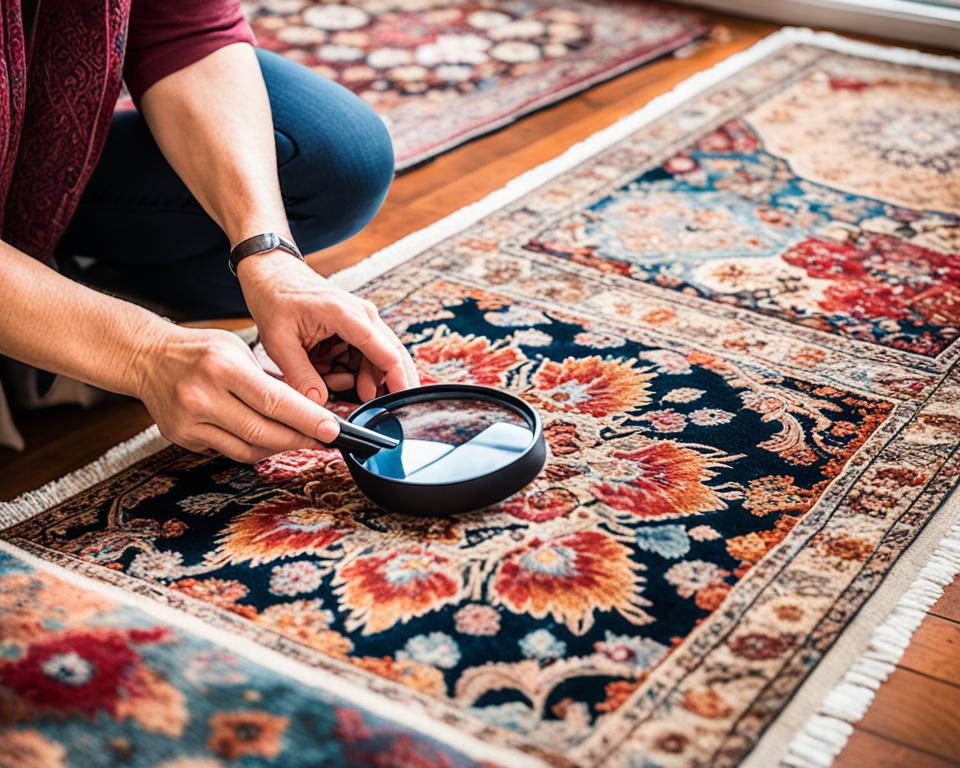
To simplify your journey in choosing the perfect rug, we’ve crafted a comprehensive table taking into consideration the essential aspects you should weigh during your selection process:
| Budget Consideration | Color Harmony | Shape Compatibility | Size Appropriateness | Type Distinction |
|---|---|---|---|---|
| What is your budget for a Persian rug? | Does the rug’s color palette complement your current decor? | What shape best fits your space and furniture layout? | Measure your area to determine the ideal rug size. | Identify the rug type that resonates with your aesthetic. |
|
|
|
|
|
Whether you desire a rug that makes a subtle statement or one that stands as a conversation starter, remember that the Best Persian Rugs blend harmoniously with your lifestyle and interior theme. These heirlooms not only anchor your space but also build a bridge to the rich tapestry of Persian history. Let your intuition and these guidelines lead you to a timeless treasure that will imbue your home with elegance for years to come.
Decorating with Luxury Rugs: Styling Tips for Your Home
When the narrative of your space embraces the sophistication of luxury rugs, each room transforms into a canvas that reflects your personal style narrative. Embrace the art of decorating with Persian rugs, and watch as they lay down more than mere groundwork; they spin a story imbued with history and tradition. Whether the grandeur of rich patterns or a subtle touch of fine texture, the right rug can elevate ordinary to a realm of extraordinary.
Incorporating Rugs into Different Room Settings
Select a Persian rug that speaks to the dimensions and color palette of your room. In expansive living areas, let an ornate centerpiece rug anchor the furniture, giving the room a sense of grounded nobility. In snugger corners, choose smaller traditional carpets to harmonize with the intimacy of the space. It’s not just about picking a rug but about crafting an atmosphere that aligns with the room’s function and aesthetic appeal.
Mixing Traditional and Modern Décor
Styling with traditional carpets doesn’t mean forsaking the modern touch that keeps a home feeling current and lively. By blending eras, a compelling contrast emerges—think a grand, hand-knotted Persian piece beneath a sleek, contemporary coffee table or straddling the juxtaposition of a minimalist living space with the intricate richness of a traditional pattern. The dance between the antique and the avant-garde adds layers to your interior narrative, capturing the eclectic essence of your tastes.
Below is a guide to help you navigate the pairing of Persian rugs within your dynamic interior spaces:
| Room | Rug Style Recommendation | Modern Accent | Tips |
|---|---|---|---|
| Living Room | Centerpiece Persian Rug | Modern Art Pieces | Allow the rug to set the color scheme and arrange modern art to complement it. |
| Dining Room | Elegant Geometric Pattern | Contemporary Lighting | Choose lighting that highlights the rug’s intricacy without overpowering it. |
| Bedroom | Soft Wool Rug | Minimalist Furniture | Balance the room with clean-lined furniture to contrast the rug’s plushness. |
| Entryway | Bold Medallion Rug | Statement Artwork | Create a welcoming intrigue with art that reflects elements of the rug. |
The essence of styling with traditional carpets lies in creating a dialogue between the pieces—where each rug starts a conversation, and every modern element responds, culminating in a home that’s as dynamic as it is timeless.
As you explore the multitude of ways to incorporate these stunning artifacts into your environment, remember that decorating with Persian rugs is not just about aesthetics but also about instilling a spirit of lived-in cultural richness that luxury rugs provide. It’s the opportunity to fashion a home that pays homage to the ancient while celebrating the chic clarity of the now— a sanctuary of style that is unequivocally yours.
The Investment Value of Persian Rugs
When it comes to interior accents that offer both ornamental charm and financial worth, Persian rug investment is unparalleled. Esteemed not just for their ability to transform a room, Persian rugs are also valued for their potential to appreciate over time. Indeed, discerning enthusiasts recognize collectible Persian rugs as substantial investments that blend exquisite artistry with historical wealth. Understanding the myriad factors that influence the value of Persian carpets can arm you with the knowledge to expand your collection with pieces that promise both aesthetic delight and fiscal prudence.
Understanding Price Factors
Frequently, the most impactful factors determining the value of Persian rugs include material quality, knot density, rarity, and the prestige of its heritage. Superior-grade silk, renowned for its sheen and durability, often elevates a rug’s worth significantly as compared to wool or cotton. Furthermore, a high knot count indicates painstaking handiwork, with some extraordinarily fine specimens flaunting over a million knots per square meter—a true sign of a rug’s luxury and investment potential.
The rarity of a rug’s design and its provenance are also vital contributors to its market price. Alongside these, the legacy of the artisans who created the piece, their techniques, and regional attributions enrich the narrative and hence the rug’s allure. Here’s how these factors can translate into potential financial gain:
| Factor | Description | Influence on Value |
|---|---|---|
| Rarity & Provenance | Unique designs, historical significance | Increases with fewer available specimens |
| Material Quality | Use of superior silk or high-grade wool | Enhances durability and aesthetics |
| Artisan Prestige | Renowned creators or regions | Boosts desirability and market price |
| Knot Density & Craftsmanship | Reflects time invested and intricacy | Indicates luxurious complexity |
Persian Rugs as Collectible Art
The aesthetic fusion of colors and patterns is just one part of what makes collectible Persian rugs truly captivating. These creations are expressions of cultural narratives, embodiments of skill passed down through generations. A collector understands that antique rugs, often linked to specific dynasties or historic periods, carry substantial cultural worth, making them smart additions to any investment portfolio.
The incalculable hours of labor and ancestral knowledge imbued within each strand of an esteemed Persian rug often are cornerstones of their valuation at top auction houses. Here are several key attributes that may suggest a rug’s potential as a collectible:
- Historical significance linked to the carpet’s origin
- Distinguishing details that underline its uniqueness
- The overall condition and age of the rug
- Artist or atelier reputation that crafted the rug
Whether you’re a seasoned collector or a novice entranced by the allure of these traditional weaves, each Persian rug you select stands as a testament to your discerning eye for both beauty and value. By factoring in all considerations—materiality, craftsmanship, rarity, and historical narrative—you can confidently curate a collection that is as much a visual joy as it is an investment in art.
Care and Maintenance of High-Quality Area Rugs
Investing in a Persian rug brings more than beauty to your home; it’s a commitment to preserving a piece of artisanal heritage. Understanding the care of Persian rugs and the maintenance of luxury rugs is crucial for sustaining their opulent appearance. Here’s a nifty guide to keeping your high-quality area rugs looking as grand as the day you unrolled them.
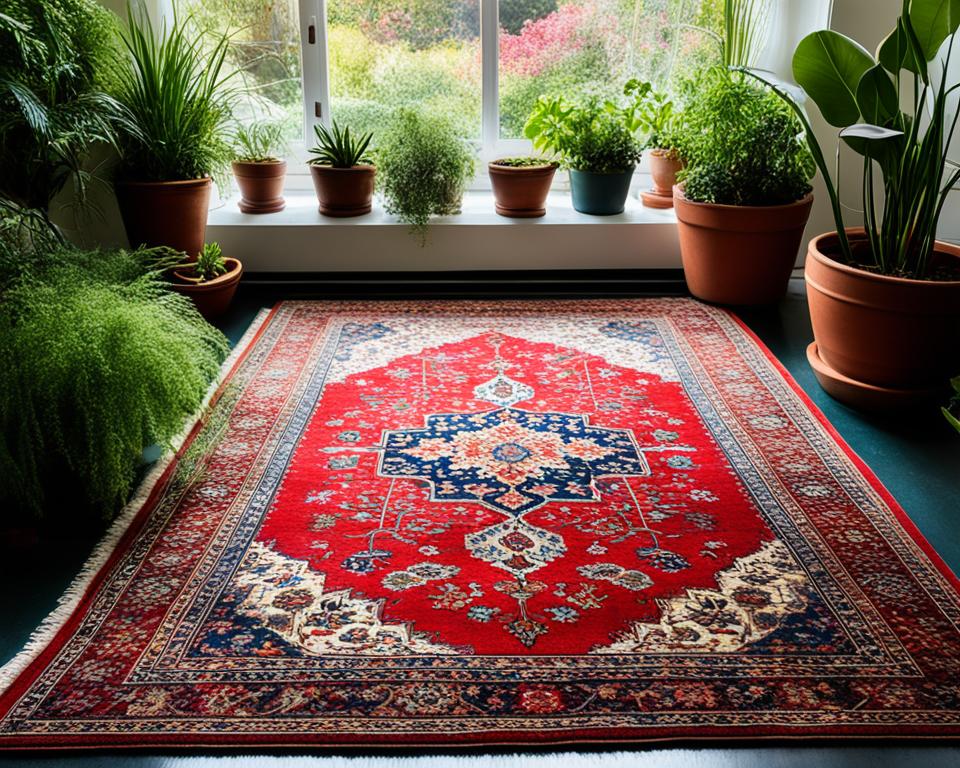
Consistent vacuuming is your first line of defense against everyday dirt and dust. Use a vacuum with gentle suction and avoid the beater bar, which can snag delicate fibers. For the best results:
- Vacuum your rug lightly but regularly to prevent dirt from settling deep within the fibers.
- Rotate your Persian rug every six months to ensure even wear and light exposure, keeping its colors vibrant.
- Attend to spills immediately with a clean, damp cloth—blot, don’t rub, to lift the stain without spreading it further.
Professional cleaning is a must every few years, depending on foot traffic. A specialized cleaner will handle your luxury rug with the expertise it deserves, employing methods optimal for its delicate materials. In the meantime, here are some tips to maintain your rug’s integrity between professional cleanings:
| Action | Purpose | Frequency |
|---|---|---|
| Gentle Vacuuming | Remove surface dirt and prevent settling | Weekly |
| Rug Rotation | Even out wear and exposure | Biannually |
| Spot Cleaning | Immediate stain removal | As needed |
| Professional Care | Deep cleaning and restoration | Every 2-5 years |
To prolong the life and appearance of your high-quality area rugs, consider these additional practices:
- Keep the rug out of prolonged direct sunlight to prevent fading.
- Invest in a quality padding to support and protect the rug from below.
- Avoid placing heavy furniture on the corners or edges to prevent curling and wear.
Your Persian rugs are more than just a purchase—they’re a narrative woven into your life. With the right care and maintenance, these luxury rugs will endure as both fixtures of beauty and as precious family heirlooms, passed down through generations to come. Embrace these tips and watch your investment retain its elegance and value over time.
Persian Rug Specialists: Where to Find Expert Advice
Entering the rich tapestry of Persian rugs introduces you to an extensive realm where Persian rug specialists hold the key to invaluable knowledge. Their guidance can help you navigate this intricate marketplace, providing expert advice on Persian carpets to enrich your understanding and appreciation of their cultural and aesthetic significance.
Utilizing Online Resources and Communities
From distinguished auction houses to online marketplaces like Nain Trading, there are countless treasure troves waiting to be discovered by both novices and seasoned collectors. These platforms not only offer access to vast collections but also the chance to engage with a community of Persian rug aficionados. Here, you can exchange stories, obtain insights, and immerse yourself in the shared passion for the rarity and fineness of Persian rugs.
Navigating Through Rarity and Fineness Rankings
The value of a Persian carpet is often reflected in its rarity and knot density, distinguishing each piece from ordinary to a highly coveted artwork. Criteria outlined by specialists delineate carpets from very fine to extraordinarily fine, speaking volumes of the intricacy and dedication woven into each knot. The table below provides an insight into the elaborate hierarchy that defines Persian rug fineness:
| Knot Density Category | Knots per Square Meter | Distinguishing Characteristics |
|---|---|---|
| Very Coarse | 40,000 – 80,000 | Simpler designs, more pronounced texture |
| Coarse | 80,000 – 120,000 | Increased definition in patterns and motifs |
| Average | 120,000 – 240,000 | Balance of clarity and textile strength |
| Fine | 240,000 – 360,000 | Rich detail and design complexity |
| Very Fine | 360,000 – 500,000 | Luxuriant textures, high level of craftsmanship |
| Extraordinarily Fine | 1,100,000 or higher | Rarest category, exceptional intricacy and rarity |
Persian rug specialists are instrumental in translating these technical details into a narrative of heritage and luxury, decoding the language woven in the warp and weft of each carpet. As you explore the market for your next Persian rug, rely on these experts and their profound insights to find a piece that resonates with both your aesthetic predilections and the silent language of Persian artistry.
Exploring Color Palettes and Design Choices
Immerse yourself in the captivating world of Persian rug color palettes and Persian rug designs, where each hue and pattern tells a story steeped in antiquity. Traditional Persian carpets offer a rich array of color palettes, from the burning crimson of a Persian sunset to the deep indigo of twilight skies, each chosen to transform your living space into an opulent haven of color. It is this mastery of color that elevates Persian rugs to more than a mere accessory; they become a central figure in your home’s narrative.
As you peruse the extensive selection, you will find the classic reds, blues, and ochres for which Persian rugs are renowned, their vibrancy rooted in the natural dyes that have been used for centuries. Connoisseurs and newcomers alike will appreciate how these traditional colors blend into modern homes, bringing warmth and comfort. Beyond these time-honored hues, artisans now incorporate a versatile spectrum of colors to suit contemporary tastes without forsaking the time-honored motifs that are a hallmark of Persian craftsmanship.
Stemming from the legacy of ancient Persia, every design in these rugs reveals the region’s culture and folklore. The iconic floral and garden motifs allude to the paradisaical Persian gardens of lore, while hunting scenes and geometrical patterns echo the dynamic tales passed down through generations. The care put into preserving these designs is palpable, making each rug not simply an item of decor but a piece of living history.
| Color Palette | Emotional Ambiance | Traditional Usage | Modern Adaptation |
|---|---|---|---|
| Reds & Oranges | Warmth and Energy | Royalty and Wealth | Dynamic Focal Points |
| Blues & Indigos | Calmness and Reflection | Spiritual Significance | Soothing Backgrounds |
| Ochres & Yellows | Elegance and Illumination | Antiquity and Rarity | Bright Accents |
| Modern Spectrum | Versatile and Up-to-date | Innovative Artistry | Contemporary Settings |
Whether you are drawn to a traditional or modern Persian rug color palette, know that you are choosing a piece that has been crafted with intent and steeped in a rich lineage of artisan skill. Allow yourself to be enchanted by the shades and designs that have adorned Persian homes and palaces for centuries, and invite into your home a Persian rug that resonates with your individual style and carries the legacy of an art form unchanged by time.
Purchasing and Shipping Considerations for Persian Rugs
When you make the decision to enhance your home with the timeless elegance of a Persian rug, understanding the nuances of purchasing Persian rugs is as crucial as selecting the perfect pattern to complement your space. Nain Trading has streamlined the process to ensure that shipping Persian carpets is seamless and worry-free. A cornerstone of our service includes offering free shipping and returns, underscoring our commitment to your satisfaction.
Your journey to owning these high-quality area rugs involves more than just choosing a design and making a payment. It includes planning for its arrival and placement in your home. With an extensive array of options available online, we provide a 31-day money-back guarantee for a risk-free acquisition experience, reinforcing our assurance that you will be nothing short of delighted with your purchase.
Here’s a concise guide to help ensure that your investment in luxury is protected from the very moment you click ‘purchase’:
| Consideration | Description | Benefit |
|---|---|---|
| Free Shipping | Complimentary delivery service for your rug. | Cost efficiency and convenience. |
| Free Returns | Option to return the rug at no extra charge if it fails to meet your expectations. | Risk mitigation and buyer confidence. |
| Money-back Guarantee | A 31-day period during which you can receive a full refund if not satisfied. | Assurance of quality and satisfaction. |
| Customer Support | Access to expert advice and assistance throughout your buying and shipping process. | Personalized service and peace of mind. |
While anticipating the arrival of your rug, familiarize yourself with the provider’s shipping policy. Renowned dealers will often include tracking services, allowing you to monitor the progress of your newest decor element as it makes its way to your doorstep. Weight the anticipated delivery timelines against your scheduling plans, making sure your household is ready to welcome its new centerpiece with open arms.
Embarking on the journey of purchasing Persian rugs imbues your home with an air of sophistication and luxury. With considerations like free shipping and a solid guarantee in place, you can shop with confidence knowing that these high-quality area rugs will soon be a part of your living space, adding warmth, culture, and a story to be treasured for generations.
The Role of Persian Rugs in Sustainable Luxury
When it comes to home décor, the fusion of luxury and sustainability is an increasingly sought-after combination. Persian rugs stand at this crossroad, representing sustainable luxury rugs that not only elevate the visual appeal of your living spaces but also adhere to environmentally conscious practices. These timeless pieces harmonize with eco-friendly lifestyles, embodying a deep-rooted tradition that complements the growing desire for green home décor.
Eco-Friendly Practices in Rug Production
Delving into the eco-friendly nature of eco-friendly Persian carpets, you find a rich narrative of sustainable craftsmanship. The selection of natural materials such as wool and the dedicated art of hand-knotting that defines Persian rug making are inherently eco-friendly. These practices bypass the need for energy-heavy machinery that characterizes mass production. By making such a choice for your home, you’re not only curating a space that boasts a high aesthetic appeal but also supporting ancient crafting traditions that prioritize the health of our planet.
Contributing to a Greener Home with Persian Rugs
Opting for Persian rugs means investing in items that last generations, contrary to the disposable nature of many modern furnishings. The durability of these meticulously crafted pieces stands in defiance of a throwaway culture, aligning with the principles of sustainability that call for fewer replacements and a lesser environmental footprint. Introducing a Persian rug into your home is more than a décor decision; it’s a step towards fostering a greener, more sustainable living space. Ultimately, by embracing these sustainable luxury rugs, you partake in an age-old tradition that offers both enduring beauty and an eco-conscious home environment.
FAQ
What sets the Best Persian Rugs apart from other luxury rugs?
The Best Persian Rugs are renowned for their outstanding craftsmanship, traditional hand-knotting techniques, and natural colorant use. They offer a unique combination of aesthetic beauty, cultural heritage, and high-quality construction that differentiates them from other luxury rugs on the market.
Can you describe the historical significance of Persian carpets?
Persian carpets are deeply rooted in the rich tapestry of ancient Persia’s opulent traditions. With origins dating back over 2500 years, they represent the artistry and ingenuity of Persian weavers through various historical periods, including the influences of Cyrus the Great, the Seljuk, and the Safavid Dynasty.
What are the characteristics of authentic Persian carpets?
Authentic Persian carpets are known for their intricate designs, fine knot density, and skilled craftsmanship. Genuine pieces will often have a million knots per square meter and feature a tight weave pattern characteristic of traditional Persian knotting techniques.
What distinct styles are there within Persian rugs?
Persian rugs offer a variety of styles and designs, each with unique characteristics. Notable types include Bakhtiari rugs with bold patterns, Tabriz rugs known for sophisticated designs, Kirman rugs featuring intricate floral motifs, and Gabbeh rugs which present a modern twist with abstract designs.
What materials are traditionally used in Persian rug making?
Persian rug materials typically include silk, wool, and cotton. Silk is often used for the most luxurious designs, wool is well-known for its durability and texture, and cotton is commonly used for the base of the rugs due to its dye-absorbing properties and affordability.
How do I know if a Persian rug is genuine?
To identify a genuine Persian rug, look for signs such as the intricacy of the pattern, tightness of the weave, and density of the knots. The natural variation in color and pattern, as well as the overall balance and harmony of the design, are also indicators of an authentic Persian rug.
What are some tips for selecting the perfect Persian rug for my home?
When selecting a Persian rug, consider your budget, the room’s size and color palette, and the desired design or pattern. Expert advice from Persian rug specialists and exploring extensive online selections can also significantly assist in the decision-making process.
How can I incorporate a Persian rug into my modern decor?
Incorporating a Persian rug into modern decor involves blending traditional elegance with contemporary flair. This can be done by using the rug as a centerpiece in a minimalist setting or by matching it with classic furniture for a more traditional approach, depending on the desired aesthetic.
What factors influence the investment value of Persian rugs?
The investment value of Persian rugs is influenced by rarity, material quality, craftsmanship, historical significance, and the condition of the rug. Collectible Persian rugs that are well-preserved and feature unique designs or historical connections can be particularly valuable.
How should I care for and maintain my high-quality Persian rug?
To maintain your high-quality Persian rug, vacuum it gently on a regular basis, attend to spills quickly and professionally clean it periodically. Rotating your rug can also evenly distribute wear and exposure to sunlight, prolonging its beauty and value.
Where can I find expert advice on Persian carpets?
Expert advice on Persian carpets can be sourced from Persian rug specialists, established dealers, and online communities dedicated to the appreciation and collection of Persian carpets. Utilizing resources like Nain Trading can provide evaluations and guarantee the quality of fine pieces.
How do Persian rugs fit into the concept of sustainable luxury?
Persian rugs exemplify sustainable luxury through their use of eco-friendly materials and traditional production methods. They are handcrafted items that promote ethical sourcing, contribute to a greener home environment, and stand the test of time, reducing the need for frequent replacements.
What should I consider when purchasing and shipping a Persian rug?
When purchasing and shipping a Persian rug, consider the reputation of the seller, the shipping policies such as free shipment and returns, the guarantees provided, and the delivery timelines. Ensure a secure and convenient purchase process by selecting reputable providers like Nain Trading.
